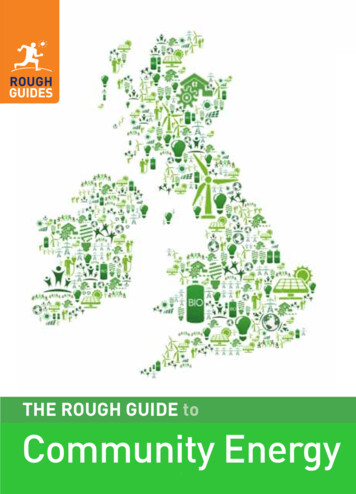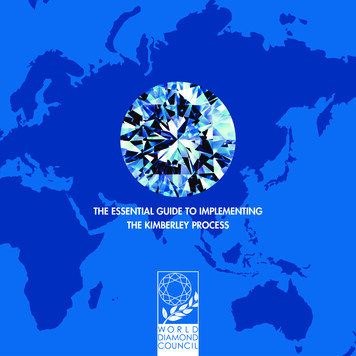
Transcription
Business ProtectionEASY TO USE EXPERT GUIDANCE TOP TIPSIn partnershipwith:
A note fromEmmaDuring my 20 years as a financial journalistI’ve worked with many people who’ve startedtheir own businesses. Most are passionateabout what they do, but they tend to focuson the day-to-day challenges of running asuccessful business; few take the time toconsider all the potential risks ahead thatcould jeopardize their hard work.The Rough Guide to Business Protection looks at one of the main risks smallbusinesses face: what happens when you lose an owner, director or key memberof your team through ill health or death. Most small businesses don’t have anytype of business protection insurance to help in such circumstances. This couldbe a very costly oversight. The guide takes you through the various types ofinsurance products available, helping you to weigh up all the options, so that youcan make an informed decision about what might be best for your business.NAVIGATING THIS EBOOKWe’ve highlighted handy Top Tips, text boxes, visual aids and tables so youcan pick out useful information that’s relevant to you, or delve deeper byreading through each chapter. Any word or phrase that is coloured andunderlined has a hyperlink, which takes you to other parts of the guide orto external websites for further information (see colour key below).COLOUR KEY:blue hyperlinks: Click to access useful resources for further guidance.purple hyperlinks: Click to navigate to the Jargon Buster (pp.50–51).orange text underlined: Click to move to other parts of the guide.Note that words coloured orange but not underlined do not have hyperlinks.
THE ROUGH GUIDETOBUSINESSPROTECTIONEmma Simon
For this edition:Author: Emma SimonEditor: Joe StainesSenior Editor: Ros WalfordDesigner: Nicola ErdpresserGraphic Designer: David BallSenior Prepress Designer: Daniel MayPicture Researcher: Aude VauconsantProofreader: Mandy TomlinAccount Manager: Michael Stanfield (Rough Guides)Digital Operations, DK Delhi:Head of Digital Operations: Manjari HoodaSenior Editorial Manager: Lakshmi RaoAssistant Producer: Suruchi KakkarProduction Coordinator: Pramod PantProducer: Rahul KumarLegal & General:With thanks to Richard Kateley, Stuart Halliwell,Richard Phillips and Leonie Scott.This first edition published September 2016 byRough Guides Ltd, 80 Strand, London WC2R 0RLwww.roughguides.comin partnership withLegal & General, Legal & General House,St Monica’s Road, Kingswood, Surrey KT20 6EUwww.legalandgeneral.com Rough Guides, September 2016978-0-2412-1515-9001-284685-Sep/16No part of this book may be reproduced in any form without permission fromthe publisher except for the quotation of brief passages in reviews.This publication is intended to provide authoritative information in regard to thesubject matter covered and, to the best of the publisher’s knowledge, the contentwas accurate and current on the date of publication. However, it is distributed withthe understanding that neither the publisher nor the author is engaged in renderingaccounting, financial or other professional services and the ideas and suggestionscontained in this book are not intended as a substitute for financial advice. If yourequire financial advice or other expert assistance, you should seek the servicesof a competent professional. Neither the author nor the publisher shall be liableor responsible for any loss or damage allegedly arising from any information orsuggestion in this book.The author has asserted her moral right to be identified as the author of this work.
THE ROUGH GUIDE TO BUSINESS PROTECTIONContentsForeword 7Chapter 1: Understanding the risks8Being prepared 9Business structures9The business lifecycle11How insurance can help14Insurance: the basics 15Chapter 2: Paying off debts 18Insuring commercial debt 19How Business Loan Protection works 19The risk of not getting cover 22The cost of Business Loan Protection 22Chapter 3: The value of a key employee24Insuring your key employees 25Key Person Protection 26Who is a key person? 27Calculating cover 28Tax considerations 30Chapter 4: Protecting the ownership of your business32Insuring your business 33When do you need Share Protection? 33Share Protection: how it works 33Valuing the business 37The importance of a Will 38Articles of Association 41Partnership agreements 41Chapter 5: How your business can protect your family42Insurance for your family 43Relevant Life Plan 43Group Benefits 46Getting advice 46Next steps 48Useful links 49Jargon buster 50
THE ROUGH GUIDE TO BUSINESS PROTECTIONRichard Kateley, Head of Intermediary Development, Legal & General6
THE ROUGH GUIDE TO BUSINESS PROTECTIONForewordLegal & General and Rough Guides have teamed up to help raise awareness of asubject that many small businesses have never considered.Rough Guides is well known for its comprehensive guides to off-the-beaten-trackplaces that help you find your way around foreign parts. In this guide we are trying to do the very same thing, slightly less exotic I would agree, but we want to letbusiness owners know some of the facts which could make their business betterprepared for its journey. We want to convert you from not knowing what you don’tknow into knowing what you need to know, and then it’s up to you if you want todo anything about it.Andrew Carnegie, the American industrialist and philanthropist, once said,“men and women, not machines, are the real source of profits in any business”.Yet, in most businesses it’s the machines and buildings that we insure: our buildings against the risk of flooding or burning down, our vehicles from being damaged, our computers from being stolen. But have you ever taken the time to thinkabout the loss of a key person or a business owner in your firm? You can rebuild abuilding, buy a new van and take delivery of a new computer, but it is not so easyto replace a business owner or a key person in your business.This guide has been put together to highlight the risks your business may berunning should you be in the unfortunate position of waking up one morning tofind that a key person in your business has suddenly died or become critically ill.How would your business cope in this situation, have you ever considered it, andis it part of any disaster recovery plan you may have?None of us wants to consider our own mortality but by doing so we can be betterprepared; thus, allowing our business to continue trading and supporting our staff,their families, our customers and anyone else who has a financial stake in the business.You will have heard of life assurance to protect your family, your mortgage andyour income. What you may not know is that a business can also insure its keypeople, owners and its debts. So if the worst were to happen to a key person withinthe business, the policy proceeds could help the business continue trading andprotect its future.At Legal & General we make a promise that every day we will help make financialsecurity easier to achieve. This Rough Guide is an important new tool that enablesus to fulfil that promise. It is designed to help you take control of your businessfinances and plan for the future, whatever stage of the business lifecycle you are at.Richard KateleyHead of Intermediary Development, Legal & General7
CHAPTER ONE:UNDERSTANDINGTHE RISKS
UNDERSTANDING THE RISKSBeing preparedSmall businesses form the backbone of the UK economy, with small andmedium-sized enterprises (SMEs) thriving in almost every sector of business,be it retail, construction, financial services, IT or health. They vary considerablyin size, some having as many as 250 employees, others as few as one. Runningan SME can be hugely rewarding, both personally and financially, but it’s a bigresponsibility and it isn’t without risk.Whether you’ve been in charge of a successful business for several years, orhave only recently started up your own enterprise, it’s important to understandthe challenges and potential pitfalls, and to think of ways of minimizing theirimpact. The Rough Guide to Business Protection aims to help you think aboutsome of the risks involved in running a small business, in particular the risks toyour key personnel.Business structuresThere are several different types of business structure in the UK, all governed bydifferent rules which determine the legal status of the business and how it is run:for example, the amount of tax you pay, who is entitled to the profits and who isliable for any debts run up by the business.The three main types of structure are:› Sole trader: This is the simplest form of business entity, as you are the soleowner and personally liable for any losses the business makes – but you alsoget to keep all the profits. Despite the name, you can actually employ staff.› Partnerships: You and your business partner(s) share responsibility forthe business. This means sharing the profits, but also being responsiblefor the losses.› Limited company: Your business is owned by its shareholders who, in manycases – especially with SMEs – will also be the company directors. Thebusiness finances are completely separate from your own personal finances.Usually, the directors are paid a salary, but they can also take dividends.For more information on the different types of business structure, see GOV.UK.If you are looking to set up your own business see The Rough Guide to Workand Money and The Rough Guide to Retirement.9
THE ROUGH GUIDE TO BUSINESS PROTECTIONTHE SMALL BUSINESS MARKET99%of the 5.4 millionbusinessesin the UKare SMEs95%24.3of SMEs havefewer than10 employees62.6%privatemillionofsectorthe numberof peopleemployedby SMEsbusinesses aresole traders81.6% of the UK workforce are employed by SMEs34% 79%of sales amongSMEs come frominternationalmarketsof SMEs havethree ownersor lessSource: Federation of Small Businesses and Legal & General’s Business Protection ReportSource: Federation of Small Businesses and Legal & General10
UNDERSTANDING THE RISKSThe business lifecycleWhatever type of operation you run, if successful it will grow and evolve overthe years. If you’re just setting up your first business, the challenges you face maybe very different to those you may encounter ten or twenty years down the line.To help understand more about these risks, it is worth identifying whereyour business is in terms of its lifecycle or growth. The Business Lifecycle infographic (p.12) highlights some of the key challenges your business is likely toface as it develops and grows.Challenges and pitfallsOn paper your idea may look like a sure-fire winner, but there can be any number of problems along the way that can destabilize your plans and, in the worsecase scenario, be a real threat to your business.Planning is the key to success and sustainability. Even if you’ve run a businessfor a number of years, it is still worth taking time to look ahead at the potentialhurdles you may face and create some contingency plans, if you haven’t doneso already. Some of the most common risks that small businesses face are listedbelow. Many small traders – even those that have been operating for years –often fail to look at the impact such events could have.› Inadequate Business Plan: Having a good business plan is crucial. It shouldset out exactly how you want your business to run and how you expect it togrow. Key details on costs, expenses, potential sales and profits should helpyou see whether the business looks sound, now and in the future. It shouldhelp to identify risks and thus allow you to prevent them, or at least protectagainst them. A good business plan can also help you to secure funding – beit a bank loan or an overdraft – which, in turn, can aid expansion. If youneed further information or guidance on putting together a business plan,go to the Federation of Small Businesses website.› Financial difficulties: There are a number of ways in which your businesscould run into financial trouble. Costs could rise – whether labour costsor the price of equipment and materials. Similarly, rents on your premisesor interest rates on loans may increase – sometimes by a lot and with littlenotice. Many businesses also struggle if they experience a drop in sales orface new competition locally. Talk to a financial adviser, or the consultantat your bank, to help ensure your business finances are robust enough toweather these problems. You can find an independent financial adviser onUnbiased.co.uk or Vouchedfor.co.uk.11
THE ROUGH GUIDE TO BUSINESS PROTECTIONTHE BUSINESS LIFECYCLEEstablished Business AGE:More than 10 years SIZE:Likely to be larger, moreprofitable enterprises TYPE:Least likelyto be sole traders ISSUES: More likely to have olderowners at greater risk ofsuffering serious illnessMaturing Business AGE:3–10 years SIZE:Most are worth morethan 250,000 TYPE:62% are limitedcompanies vs 22%sole traders ISSUES: Most likely to have someform of borrowing andcorporate debtNewer Business AGE:Less than 2 years SIZE:Most likely to besmaller businesses TYPE:50% of new businessesare sole traders ISSUES: Reliant on one or twokey individualsSource: Legal & General12
UNDERSTANDING THE RISKS› Business disruption: The best-laid plans can often be undermined by eventsquite beyond your control. In recent years, flooding has affected businesses,both large and small, throughout the UK. Fire can also cause substantialdamage to premises. As well as having adequate building and contentsinsurance (to pay for repairs to property and equipment), it’s worth drawingup a business interruption plan to set out how you would continue to tradein difficult circumstances. If you need help drawing up such a plan, see thisuseful document on GOV.UK.› Legal action and compensation claims: What if a customer or supplierwere injured on your premises? Or your computer’s security systems werebreached, revealing customers’ financial data? Businesses could face heftybills for compensation. You can minimize these risks by ensuring that youfollow appropriate health and safety guidelines, and by getting advice ondata protection and how to update your computer systems. It’s also possibleto get public liability insurance, which could cover the cost of compensationin the event of a claim. The Association of British Insurers providesinformation on the different types of commercial insurance.› Loss of key individuals: Your business is more than its premises, equipmentand bank balance. In many cases, it is the vision and commitment of theowner, partners and key employees that is the vital element in driving itforward. Because of this, it is important to think about how your businesswould cope, if you were to lose a crucial individual – particularly as a resultof ill health or death – and the effect such a loss would have on the success,future and indeed the viability of your business. This is the main focus ofThe Rough Guide to Business Protection.13
THE ROUGH GUIDE TO BUSINESS PROTECTIONHow insurance can helpIf you are already running a small business, it’s highly likely that you will havesome form of commercial insurance in place. For example, if you have staff, itis obligatory for you to have employers’ liability insurance; similarly, any commercial vehicles will need motor insurance.It is possible to buy additional insurance to help manage some of the risks TOP TIP No business islisted in the Challenges and Pitfallsentirely safe from hackers, butsection (pp.11–13). You can insure yourthere are certain basic steps youcan take to protect your businesspremises, your IT equipment, yourfrom cybercrime, such as installstock, any specialist machinery and soing updates promptly, choosingon. Most business owners are awarestrong passwords, using antiof this and seek appropriate cover.virus software and training staffHowever, these same companies are farabout the risks. For informationon how to draw up a risk manless likely to insure the health, or theagement plan, see GOV.UK.lives, of the key individuals who keepthe operation running. Even when afirm has a business disruption plan toensure trade continuing in the event of flood, fire or computer failure, it won’tnecessarily have a similar plan to assess the impact of losing key staff throughdeath or illness.For example, if your business partner suddenly died, would the business haveto find the money to pay back loans he, or she, had underwritten? Or if youbecame critically ill, would there be the funds to pay a replacement to ensurethe business is still performing when you recover? The sad truth is that such anevent could prove catastrophic. Insurance can help lessen the financial impactof such events in a number of ways. These include:› The repayment of business debts› Provision of funds to help find and recruit specialist staff› Purchasing of shares from a deceased business partner or director’s estateYou may not necessarily need the full range of policies, because much willdepend on the size and type of business you run.14
UNDERSTANDING THE RISKSThe smaller the business, the greater the riskResearch from Legal & General shows that if a key person died or becamecritically ill, four out of ten businesses would cease trading within a year. Ifyou are a small business, such a loss is likely to have a much greater impactthan it would on a larger organization. There will be fewer people to pick upthe pieces and ensure everything continues to run smoothly: most smalleroperations don’t have specialist finance departments, HR teams or legaldepartments to help them through hard times. Despite the risks, it is smallercompanies that are least likely to have business protection insurance in place,yet these are the very businesses who may be in most need of this protection.Insurance: the basicsAs stated above, there are various kinds of business or commercial insurance.This guide focuses on the different types of business protection insurance, aform of life insurance taken out by smaller and larger businesses to give themsome protection against the death of key personnel. Standard insurance termsare explained in the Jargon Buster at the back of this book.Life insurance is fairly straightforward: you pay a premium to the insurancecompany based on:›››››The length of time you need the insurance forYour ageYour healthThe amount of cover you want (the amount to be paid out at your death)The type of coverThe price goes up as the chances of dying increases (for example, if you areover a certain age or a smoker). The person whose life is being covered is knownas the life assured.Business protection insuranceFor business protection – as with personal protection – it is possible to havemore than one life insured. In most cases, the cash sum paid out would go tothe business or remaining owners. There are three different types of businessprotection insurance, these are:› Business Loan Protection (see Chapter 2)› Key Person Protection (Chapter 3)› Share Protection (Chapter 4)15
THE ROUGH GUIDE TO BUSINESS PROTECTIONBUSINESS PROTECTION INSURANCE: TYPES OF COVERNAME OFINSURANCEDEFINITIONWHO IS COVERED?WHO BENEFITS?Business LoanProtectionA type of lifeinsurance, boughtby businesses. It willhelp pay off businessdebts if the ownerdies. Critical illnesscover option alsoavailable.Anyone who hasguaranteed thesedebts – usuallythe owner, butcan be a partneror director of thebusiness.The business.Debts are repaidat a difficult time.Key PersonProtectionA type of lifeinsurance boughtby businesses.Payout providesfunds to help findreplacement staff,and cover lost profitstreams. Criticalillness cover optionalso available.Any key memberof staff. It could bea chief executive,finance director,salesmen, directoror owner.The business.Funds available tohelp find suitablereplacementor replace lostprofits.ShareProtectionA type of lifeinsurance boughtby businesses,which ensuresthere are fundsto help purchaseshares if an owner/shareholder dies.Critical illness coveroption available.Owners of thebusiness.The proceedsare paid to theremaining ownersso that they canbuy the shares fora fair value fromthe estate andthus retain controlof the business.Relevant LifePlansAn individual lifeinsurance policy thatcompany directorsand owners canbuy through theirbusiness, if theyare classed as anemployee.Employees of asmall business.The family ofthe director oremployee that itwas taken out for.Source: Legal & General16
UNDERSTANDING THE RISKSThese are designed to ensure your business is able to continue trading in difficult circumstances and help protect its future. As with any insurance policy, youneed to look at who is covered, how much would be paid out, and what eventswould trigger a payout. You also need to consider any limitations to the cover,as in what is not covered. For key information about these types of insurance,see Business Protection insurance: types of cover (p.16).There is usually the option to add on critical illness cover (see Critical illnesscover box, below), which could ensure a payout if an owner, partner, member,director or key employee became criticallyill with a specified illness, although this TOP TIP Don’t assume thatwill generally push up the cost of cover.your critical illness insurancepolicy covers you for anyIt is also possible to buy individualmedical condition that needslife insurance through the business forhospital treatment. Alwaysemployees to protect their families, rathercheck the insurance policythan the business itself. This type ofdocument to find out exactlypolicy is known as Relevant Life Plan.which conditions are covered.More details are given in Chapter 5.Critical illness coverCritical illness cover is an insurance policy that pays out a lump sumif you’re diagnosed with a specified critical illness covered by your plan.It can be bought as a stand-alone policy, or as an add-on at the outset tostandard life cover. The policy pays out if the policy-holder is diagnosedwith one of the specified illnesses during the term of the policy. The accompanying policy documents will set out exactly what conditions are covered.Most policies will cover many of the most serious illness we have probablyall heard of, such as cancer, heart attack and stroke, but only more severecases of these conditions. Early stage cancers, those that are picked up inroutine diagnostic tests, may not be covered, while more advanced cancersalmost certainly will be. Other conditions, such as multiple sclerosis, motorneurone disease, paralysis or loss of a limb, may also be covered. The exactdefinitions and number of conditions can vary between insurance companies, but most of the leading providers cover over forty different conditions.17
CHAPTER TWO:PAYING OFFDEBTS
PAYING OFF DEBTSInsuring commercial debtIf you have a mortgage, the chances are you also have some form of life insurance.This is a policy that can be used towards paying off a mortgage debt in the eventof your death within the duration of the plan, thus keeping the roof over the headsof your nearest and dearest.Most small businesses have some form of debt, be it overdrafts, loans or mortgages. These loans can help a business prosper and grow. But a significant proportion of small businesses do not have any form of insurance backing this debt.If the owner died, or was taken critically ill, these loans could quickly become aliability. Insurance can help keep the roof on your business, protecting partners,members, directors and employees – as well as their families.How Business Loan Protection worksBusiness loan insurance can cover any type of commercial debt. This includes:› Overdrafts› Commercial loans› Commercial mortgages› Directors’ Loans19
THE ROUGH GUIDE TO BUSINESS PROTECTIONWith Business Loan Protection, owners, partners or directors can insure thesize of any outstanding debt, and in the event of their death this will be repaid.The larger the debt, the higher the premiums will be, but, for simple life cover,this is one of the cheapest forms of business protection insurance.Most insurers offer the option to take out critical illness cover as well, whichcan help repay any debts that occur, if the business owner is diagnosed with oneof the specified critical illnesses outlined in the policy. When a valid claim ismade this sum is paid to the ERDRAFTPERSONALLOAN FORBUSINESSAveragebusinessborrowing isBUSINESSLOAN 344,000Source: Legal & GeneralSource: L&G Business Protection Report - page n/sales-aid/W13220.pdfWhose life is covered?Coverage depends on who has “guaranteed” the loan. Most commercial lenders will want a named individual (or individuals) as guarantors on the loanagreement – this is usually the business owner or one or more partners. Theindividual will be liable for this debt, if there aren’t sufficient assets in the business to repay the loan.20
PAYING OFF DEBTSDirectors’ LoansSome small businesses struggle to get finance. Banks and other commercial lendersmay be unwilling to advance credit to start-up firms, or may charge prohibitivelyhigh interest rates. As a result, many people starting a new business can end upinvesting their own money in it, oftenby taking out a mortgage on their own TOP TIP It is sometimeshome. A Directors’ Loan effectively enacheaper to extend your mortgagebles you to ring-fence this investment, soor take out a personal loan, thanit is to raise a commercial loan.that when the business becomes profitHowever, this does mean thatable you can take it out again.your personal assets are at risk,This can be particularly important ifif the business gets into difficulty.you run the business with other directors. Individual directors can safeguardtheir own investments in the business by setting up a Directors’ Loan account.This is a loan to the business that has to be declared via the company’s accounts.It can also be set up so that you don’t have to take profits out of the business.Almost one in three business owners (28%) are unaware that these loans haveto be repaid in the event of the director’s death. If neither the director nor thebusiness have life insurance, it may be difficult to repay these loans. This couldleave companies with a black hole in their accounts, and put a severe financialstrain on the business at an already difficult time.TOP 5 REASONS PEOPLE CHOOSE A DIRECTORS’ LOAN ACCOUNT1: 47% AS START-UP CAPITAL2: 44% TO FUND BUSINESS EXPANSION3: 32% TO BUY SHARES4: 13% DUE TO LACK OF CREDIT ELSEWHERE5: 10% SO THAT PROFITS ARE NOT TAKEN FROM THE BUSINESSSource: Legal & General21
THE ROUGH GUIDE TO BUSINESS PROTECTIONThe risk of not getting coverIf your business fails, due to the death of the owner, or a partner, and there aren’tsufficient assets to cover the debts, then a lender could seek repayment from theguarantor, or their estate. This could mean your personal assets, including yourhome might be at risk, and could leave a business owner’s family struggling torepay any business debts.Similarly, if a Directors’ Loan account is not insured, and the director dies, thebusiness may have to sell assets at short notice to repay the loan. If it is unable todo this, the business could be forced into administration, leaving the director’sfamily out of pocket. TOP TIP Banks may offer insurance against a loan. However, it makessense to get independent financial advice to ensure that you are not payingover the odds and the cover is what you need. To find a financial adviserspecializing in small businesses, see unbiased.co.uk.Which businesses are most at risk?Smaller firms are far less likely than larger ones to insure business debts. Only58% of small- or medium-sized companies insure their debts, while just 43%of recent start-ups have this cover. Unfortunately, it is these businesses that areoften least able to be able to repay their debts in the event of the death of anowner or partner. This may leave them vulnerable to bankruptcy, and couldleave the owners’ personal wealth at risk.The cost of Business Loan ProtectionThe cost of insurance will depend on a number of factors, the most importantof which are your age and the size of the loan you are insuring. The bigger theloan and the older you are, the more expensive the premiums will be. Includingcritical illness cover on top of basic life insurance will increase the cost substantially, as The cost of Business Loan Protection table below shows, but thisextra expense can provide you with added peace of mind. Having a policy couldhelp ease the potential financial burden of being unable to work, making life abit easier at a difficult time.22
PAYING OFF DEBTSThe term of the loan will also affect its costs. The longer the term the higherthe premium will be, as there is a greater chance that you will make a claim(particularly because you will be older during the latter years of the policy).Before taking out a policy, an insurer will ask basic health and lifestyle questions:smokers or those in poor health will pay larger premiums.The cost of Business Loan ProtectionBusinessownerSize ofloanTerm ofloanMonthly costof lifeinsuranceMonthly cost oflife & criticalillness coverAged 35 100,00010 years 6.31– 12.11 23.32– 33.64Aged 45 150,00010 years 14.26– 29.60 71.22– 106.89Aged 50 250,00010 years 31.74– 58.27 174.51– 270.03Source: Legal & GeneralPlease note: The table assumes the policy holders are non-smokers and in goodhealth. Quotes obtained from leading Business Protection insurance providers,correct as of July 2016. Your actual premium will depend on your individualcircumstances. As with all insurance policies, there are exclusions and limitations.23
CHAPTER THREE:THE VALUE OF AKEY EMPLOYEE
THE VALUE OF A KEY EMPLOYEEInsuring your key employeesMost small businesses insure their premises, their stock, and their fixtures andfittings. If a business is h
The Rough Guide to Business Protection. looks at one of the main risks small businesses face: what happens when you lose an owner, director or key member of your team through ill health or death. Most small businesses don’t have any type of business protection insurance to help in s










